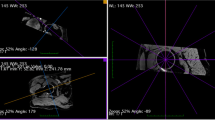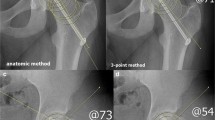Abstract
Purpose
Alpha and beta angles are commonly used radiographic measures to assess the sphericity of the proximal femur and distance between the pathologic head–neck junction and the acetabular rim, respectively. The aim of this study was to explore the relationship between these two measurements on frog-leg lateral hip radiographs.
Methods
Fifty frog-leg lateral hip radiographs were evaluated by two orthopaedic surgeons and two radiologists. Each reviewer measured the alpha and beta angles on two separate occasions to determine the relationship between positive alpha and beta angles and the inter- and intra-observer reliability of these measurements.
Results
There was no significant association between positive alpha and beta angles, [kappa range −0.043 (95 % CI −0.17 to 0.086) to 0.54 (95 % CI 0.33–0.75)]. Intra-observer reliability was high [alpha angle intra-class correlation coefficient (ICC) range 0.74 (95 % CI 0.58–0.84) to 0.99 (95 % CI 0.98–0.99) and beta angle ICC range 0.86 (95 % CI 0.76–0.92) to 0.97 (95 % CI 0.95–0.98)].
Conclusions
There is no statistical or functional relationship between readings of positive alpha and beta angles. The radiographic measurements resulted in high intra-observer and fair-to-moderate inter-observer reliability. Results of this study suggest that the presence of a CAM lesion on lateral radiographs as suggested by a positive alpha angle does not necessitate a decrease in clearance between the femoral head and acetabular rim as measured by the beta angle and thus may not be the best measure of functional impingement. Understanding the relationship between these two aspects of femoroacetabular impingement improves a surgeon’s ability to anticipate potential operative management.
Level of evidence
III.


Similar content being viewed by others
References
Barton C, Salineros MJ, Rakhra KS, Beaule PE (2011) Validity of the alpha angle measurement on plain radiographs in the evaluation of cam-type femoroacetabular impingement. Clin Orthop Relat Res 4692:464–469
Beaule PE, Zaragoza E, Motamedi K, Copelan N, Dorey FJ (2005) Three-dimensional computed tomography of the hip in the assessment of femoroacetabular impingement. J Orthop Res 236:1286–1292
Beck M, Kalhor M, Leunig M, Ganz R (2005) Hip morphology influences the pattern of damage to the acetabular cartilage: femoroacetabular impingement as a cause of early osteoarthritis of the hip. J Bone Joint Surg Br 877:1012–1018
Bedi A, Zaltz I, De La Torre K, Kelly BT (2011) Radiographic comparison of surgical hip dislocation and hip arthroscopy for treatment of cam deformity in femoroacetabular impingement. Am J Sports Med 39(Suppl):20S–28S
Bhandari M, Chiavaras M, Ayeni O, Chakraverrty R, Parasu N, Choudur H, Bains S, Sprague S, Petrisor B, Assessment Group for Radiographic Evaluation and Evidence (AGREE) Study Group (AGREE Investigators Writing Committee) (2013) Assessment of radiographic fracture healing in patients with operatively treated femoral neck fractures. J Orthop Trauma 279:e213–e219
Bhandari M, Chiavaras MM, Parasu N, Choudur H, Ayeni O, Chakravertty R, Bains S, Hak A, Sprague S, Petrisor B (2013) Radiographic union score for hip substantially improves agreement between surgeons and radiologists. BMC Musculoskelet Disord 14:70-2474-14-70
Brunner A, Hamers AT, Fitze M, Herzog RF (2010) The plain beta-angle measured on radiographs in the assessment of femoroacetabular impingement. J Bone Joint Surg Br 929:1203–1208
Carlisle JC, Zebala LP, Shia DS, Hunt D, Morgan PM, Prather H, Wright RW, Steger-May K, Clohisy JC (2011) Reliability of various observers in determining common radiographic parameters of adult hip structural anatomy. Iowa Orthop J 31:52–58
Chiavaras MM, Bains S, Choudur H, Parasu N, Jacobson J, Ayeni O, Petrisor B, Chakravertty R, Sprague S, Bhandari M (2013) The Radiographic Union Score for Hip (RUSH): the use of a checklist to evaluate hip fracture healing improves agreement between radiologists and orthopedic surgeons. Skeletal Radiol 428:1079–1088
Clohisy JC, Zebala LP, Nepple JJ, Pashos G (2010) Combined hip arthroscopy and limited open osteochondroplasty for anterior femoroacetabular impingement. J Bone Joint Surg Am 928:1697–1706
Clohisy JC, Nunley RM, Otto RJ, Schoenecker PL (2007) The frog-leg lateral radiograph accurately visualized hip cam impingement abnormalities. Clin Orthop Relat Res 462:115–121
Cohen J (1960) A coefficient of agreement for nominal scales. Educ Psychol Measur 20:37–48
Dudda M, Albers C, Mamisch TC, Werlen S, Beck M (2009) Do normal radiographs exclude asphericity of the femoral head-neck junction? Clin Orthop Relat Res 4673:651–659
Dunn DM (1952) Anteversion of the neck of the femur; a method of measurement. J Bone Joint Surg Br 34(B2):181–186
Fleiss JL (1981) Statistical methods for rates and proportions. John Wiley and Sons, New York
Ganz R, Parvizi J, Beck M, Leunig M, Notzli H, Siebenrock KA (2003) Femoroacetabular impingement: a cause for osteoarthritis of the hip. Clin Orthop Relat Res 417:112–120
Gosvig KK, Jacobsen S, Sonne-Holm S, Gebuhr P (2008) The prevalence of cam-type deformity of the hip joint: a survey of 4151 subjects of the Copenhagen Osteoarthritis Study. Acta Radiol 494:436–441
Hack K, Di Primio G, Rakhra K, Beaule PE (2010) Prevalence of cam-type femoroacetabular impingement morphology in asymptomatic volunteers. J Bone Joint Surg Am 9214:2436–2444
Henebry A, Gaskill T (2013) The effect of pelvic tilt on radiographic markers of acetabular coverage. Am J Sports Med 4111:2599–2603
Hetaimish BM, Khan M, Crouch S, Simunovic N, Bedi A, Mohtadi N, Bhandari M, Ayeni OR (2013) Consistency of reported outcomes after arthroscopic management of femoroacetabular impingement. Arthroscopy 294:780–787
Janssen MM, Drevelle X, Humbert L, Skalli W, Castelein RM (2009) Differences in male and female spino-pelvic alignment in asymptomatic young adults: a three-dimensional analysis using upright low-dose digital biplanar X-rays. Spine (Phila Pa 1976) 3423:E826–E832
Johnston TL, Schenker ML, Briggs KK, Philippon MJ (2008) Relationship between offset angle alpha and hip chondral injury in femoroacetabular impingement. Arthroscopy 246:669–675
Kapron AL, Anderson AE, Peters CL, Phillips LG, Stoddard GJ, Petron DJ, Toth R, Aoki SK (2012) Hip internal rotation is correlated to radiographic findings of cam femoroacetabular impingement in collegiate football players. Arthroscopy 2811:1661–1670
Kapron AL, Anderson AE, Aoki SK, Phillips LG, Petron DJ, Toth R, Peters CL (2011) Radiographic prevalence of femoroacetabular impingement in collegiate football players: AAOS Exhibit Selection. J Bone Joint Surg Am 9319:e111 (1–10)
Kumar R, Aggarwal A, Krishnan V, Gopinathan N, Chakraborty S (2013) Femoroacetabular impingement and comparison of radiological indexes: a study on 50 cases. Musculoskelet Surg 972:153–158
Landis JR, Koch GG (1977) The measurement of observer agreement for categorical data. Biometrics 331:159–174
Mast NH, Impellizzeri F, Keller S, Leunig M (2011) Reliability and agreement of measures used in radiographic evaluation of the adult hip. Clin Orthop Relat Res 4691:188–199
Mathew G, Kowalczuk M, Hetaimish B, Bedi A, Philippon MJ, Bhandari M, Simunovic N, Crouch S, Ayeni OR, Faith Investigators (2014) Radiographic prevalence of CAM-type femoroacetabular impingement after open reduction and internal fixation of femoral neck fractures. Knee Surg Sports Traumatol Arthrosc 224:793–800
McKibbin B (1970) Anatomical factors in the stability of the hip joint in the newborn. J Bone Joint Surg Br 521:148–159
Meyer DC, Beck M, Ellis T, Ganz R, Leunig M (2006) Comparison of six radiographic projections to assess femoral head/neck asphericity. Clin Orthop Relat Res 445:181–185
Nepple JJ, Carlisle JC, Nunley RM, Clohisy JC (2011) Clinical and radiographic predictors of intra-articular hip disease in arthroscopy. Am J Sports Med 39(2):296–303
Neumann M, Cui Q, Siebenrock KA, Beck M (2009) Impingement-free hip motion: the ‘normal’ angle alpha after osteochondroplasty. Clin Orthop Relat Res 4673:699–703
Notzli HP, Wyss TF, Stoecklin CH, Schmid MR, Treiber K, Hodler J (2002) The contour of the femoral head-neck junction as a predictor for the risk of anterior impingement. J Bone Joint Surg Br 844:556–560
Ranawat AS, Schulz B, Baumbach SF, Meftah M, Ganz R, Leunig M (2011) Radiographic predictors of hip pain in femoroacetabular impingement. HSS J 72:115–119
Siebenrock KA, Kalbermatten DF, Ganz R (2003) Effect of pelvic tilt on acetabular retroversion: a study of pelves from cadavers. Clin Orthop Relat Res 407:241–248
Sim J, Wright CC (2005) The kappa statistic in reliability studies: use, interpretation, and sample size requirements. Phys Ther 853:257–268
Tannast M, Siebenrock KA, Anderson SE (2007) Femoroacetabular impingement: radiographic diagnosis–what the radiologist should know. AJR Am J Roentgenol 1886:1540–1552
Conflict of interest
The authors certify that they, or a member of their immediate families, have no funding or commercial associations (eg, consultancies, stock ownership, equity interest, patent/licensing arrangements, etc) that might pose a conflict of interest in connection with the submitted article.
Ethical standards
Local Research Ethics approval was obtained from REB # 13-318-C.
Author information
Authors and Affiliations
Corresponding author
Rights and permissions
About this article
Cite this article
Khan, M., Ranawat, A., Williams, D. et al. Relationship between the alpha and beta angles in diagnosing CAM-type femoroacetabular impingement on frog-leg lateral radiographs. Knee Surg Sports Traumatol Arthrosc 23, 2595–2600 (2015). https://doi.org/10.1007/s00167-014-3182-3
Received:
Accepted:
Published:
Issue Date:
DOI: https://doi.org/10.1007/s00167-014-3182-3




